5 Proven Ways to Get Poop Out of Clothes
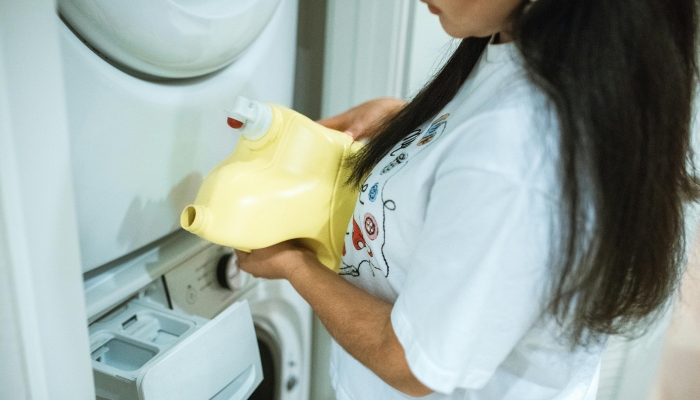
This post may contain affiliate links; please see our terms of use for details.
- There are several methods to get poop out of clothes, including soaking, machine washing, and natural remedies.
- It’s essential to pretreat stained clothing to prevent the stain from setting in.
- Immediately tackling stains helps make the process of getting poop out of clothes easier.
I still remember sitting at a restaurant, holding my infant, when I felt something wet. I don’t need to go into the details—you know where this is going. As parents, it’s not unusual to find poop on your clothing or your child’s, but what’s the best method to get it out?
Learning how to get poop out of clothes without having to throw them away is vital so you aren’t unnecessarily dropping money on new clothes.
As parents, we frequently learn as we go, so you’ll likely find one method that works better for your needs.
1. Pre-Treatment Steps
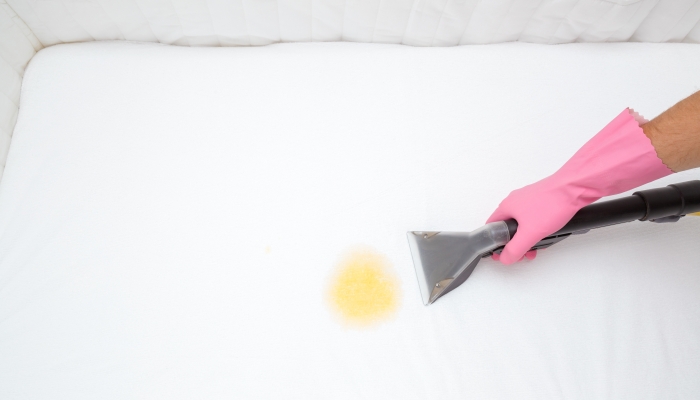
If diamonds are a woman’s best friend, a diaper blowout is her worst enemy. With three kids, I’ve had my fair share of “poo-namis,” as my best friend called them. In my naive days, I admittedly threw away soiled clothing because I didn’t think it stood a chance of survival.
However, I learned my lesson once my second and third came along. One of the most critical steps to getting poop out of clothes is to scrape excess poop while avoiding spreading the stain gently. Next, you’ll want to use cold water to prevent the protein in the stain from setting.
The key is to start the process immediately and not put the items in the washing machine until you’ve pre-treated and soaked them.
2. Soaking
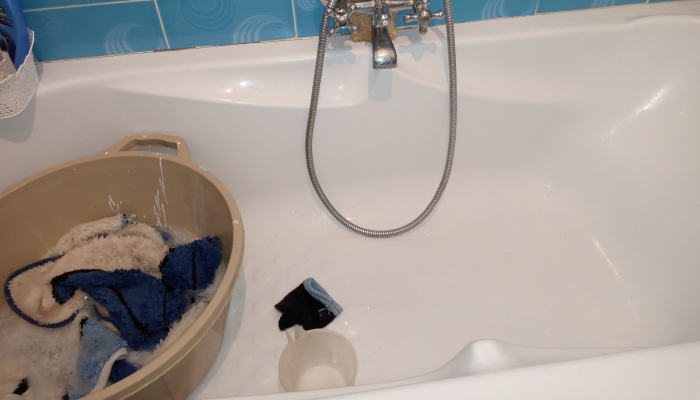
Once you’ve pretreated your clothes, it’s best to soak them in enzyme-based detergents to break down proteins. Detergents with enzyme ingredients11. Anderson, E., & Zagorski, J.. Trending – Laundry Detergent Enzymes. Center for Research on Ingredient Safety. 2022. https://www.canr.msu.edu/news/trending-laundry-detergent-enzymes help accelerate chemical reactions and processes to break down stains and dirt on fabric.
While there is research on some enzymes that can trigger allergic reactions, scientists have determined that enzymes in laundry detergents are safe and effective. If you experience an allergic reaction, it’s likely due to the fragrance or another ingredient, not the enzymes.
Ideally, you’ll use a laundry detergent with hydrolases22. Hede, P. D.. A beginner’s guide to enzymes in detergents. Novozymes. 2020. https://biosolutions.novozymes.com/en/dish/insights/article/beginners-guide-enzymes-detergents to break down protein; however, it’s not found in all detergents with enzyme ingredients.
Here are a few detergents with enzyme ingredients:
- DEEP CLEAN: For a deep clean that’s gentle on skin. Removes more stains than the leading Free detergent
- Free from dyes and perfumes for a laundry detergent that’s gentle on your skin and clothes
- Hypoallergenic laundry detergent that’s specially formulated to minimize the risk of skin irritation and allergies
- No matter what type of machine you have or the water temperature you prefer, Tide Free & Gentle ensures exceptional cleaning results every time
- Powerful Bio Enzymatic Cleaner: ACTIVE Laundry Odor Removers Boost your normal laundry detergent to effectively target Stains & Odors, not mask them like washing soda or in-wash scent boosters. It uses Lab-proven Biological Cleaning to remove laundry odor & strong smell
- Heavy Duty Stain Remover for clothes: Our Enzyme Laundry Additive Powder is formulated for Stain Removal of dirty clothes, perfect for Funk, Grease, Armpit Sweat stain, Blood stain, Oil and more!
- Gentle on All Fabrics: Our Fragrance Free Laundry Boost Plant-based Formula uses zero harsh chemicals. Natural enhancer for whites & colors. Even safe for pesky activewear fabrics
- Value 64 Load Package: ACTIVE Enzyme Cleaner Concentrated 32-oz size is good for 64 Loads compared to other products with 1 lb or less
Lastly, how long you need to soak your clothes varies. Ideally, you’ll soak them for several hours for optimal results, but I frequently soak items overnight for maximum results.
- CLIMATE POSITIVE AND SUSTAINABLE – Not only is this laundry detergent formula effective and kind to sensitive skin, but it’s also pH-balanced.
- 100% VEGAN – Containing enough detergent for 100 loads of laundry, plant-powered ECOS Laundry Detergent is both cruelty-free and vegan, making it an ideal choice for planet-conscious households.
- PARABEN AND PHOSPHATE FREE – Unlike most conventional laundry detergents, ECOS does not contain any harsh chemicals or ingredients that can pollute water when it enters the ecosystem.
- DERMATOLOGIST-TESTED AND HYPOALLERGENIC – ECOS Laundry Detergent is an effective yet gentle cleaning solution for clothes that is suitable for families with skin allergies and sensitivities.
3. Hand Washing
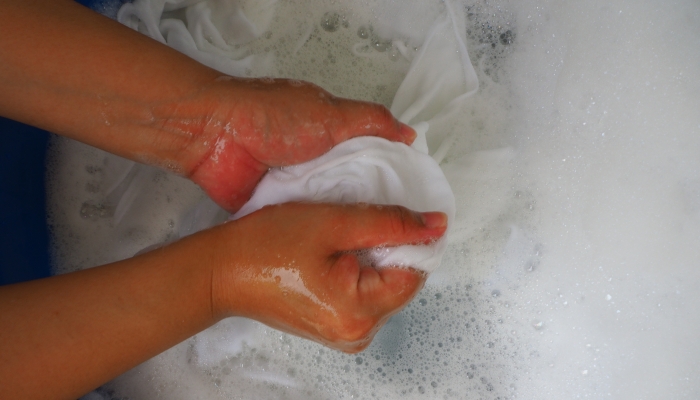
You can wash most baby clothes in the washer, but some benefit from hand washing, especially when getting stains out. If your baby doesn’t have sensitive skin, I highly recommend using Dawn Powerwash Spray. While it’s meant for dishes, it works amazingly on stains.
- Removes 99% of grease and grime in half the time (vs. Dawn Non-Concentrated; based on a P&G study, March 2024)
- 5X FASTER Grease Cleaning (vs. Dawn Non-concentrated, based on a P&G Study, March 2024)
- 3 cleaning boosters not found in traditional dish soaps
- Power of an overnight soak in minutes
My boys’ white uniform shirts frequently don’t look white, so I spray them with Powerwash and let them sit before cleaning. Sometimes, the stains completely vanish; it’s impressive.
However, if you want to use something gentler, opt for a detergent like Dreft Newborn Baby Liquid Laundry Detergent, which has no added chlorine, dyes, or phosphates.
- 3-IN-1 FORMULA: Our Dreft baby laundry detergent fights odors, helps remove stains, and is gentle on sensitive skin, making them perfect for newborn essentials
- EFFECTIVE CLEANING: Dreft baby laundry detergent cleans effectively, specifically designed to tackle milk and spit-up stains
- HYPOALLERGENIC: Dreft Stage 1 Newborn baby laundry detergent is hypoallergenic and gentle, with no added chlorine, dyes, or phosphates, making them a must-have in your baby essentials
- PEDIATRICIAN RECOMMENDED: Dreft is the # 1 pediatrician recommended baby detergent brand, trust the experts for your laundry soap needs
When hand washing, follow these steps:
- Fill a container with warm water and detergent, thoroughly mixing the solution.
- After pre-treating the stain, submerge the clothing in water and gently wash it with your hands.
- Leave the clothing item in the solution and let it sit for up to 30 minutes.
- Drain the dirty water, replace it with fresh water, and gently rinse your item.
- Avoid wringing the item, which can cause damage just like a washing machine.
- Continue replacing the water as needed, ensuring you remove the soap.
- Lay your item flat to dry, like on a towel, clothing rack, or in the sun.
Tip: To help remove excess moisture, wrap your item in a towel and squeeze it gently.
4. Machine Washing
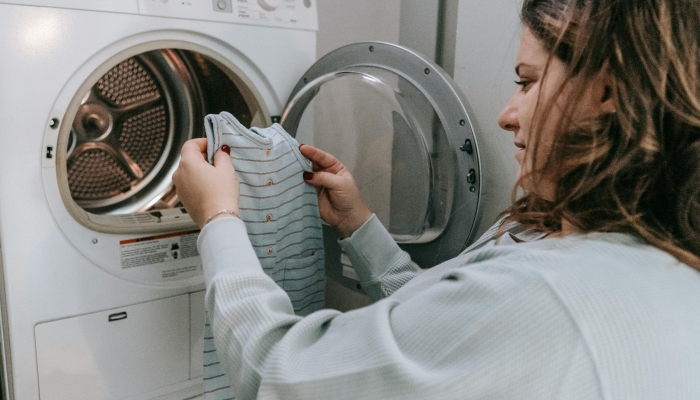
Your washing machine is another excellent option for getting poop out of clothes; however, it’s essential to follow the pre-treatment steps before putting the item in the wash. Typically, the stain will set in if you only machine wash.
Generally, you want to use the hottest setting to help break down and remove the stain. Many washing machines have a sanitary setting ideal for cleaning soiled clothing, and you also want to ensure you wash clothing with the soiled part facing out.
You can also add a stain remover, like OxiClean Free Versatile Stain Remover Powder.
- One 3 lb container of OxiClean Free Versatile Stain Remover Powder with 101 uses and counting for laundry and around the home
- Dye-free, perfume-free OxiClean powder laundry booster removes everyday dirt and tough set-in stains from machine-washable t-shirts, sheets, towels, shoes, hats, workout gear, and kids’ and baby clothes
- This oxygen-powered, water-activated, septic tank-free stain remover powder fights tough stains and everyday messes with a color-safe, chlorine-free stain cleaner formula that is gentle on fabrics
- Mix this multi purpose cleaner with water into a cleaning solution following label directions to use as a kitchen cleaner, bathroom cleaner, furniture cleaner and floor cleaner for nearly any hard or soft surface in your home
You should check the clothing before drying to ensure the stain is gone. If it’s still there, repeat the washing process before drying.
5. Natural Remedies
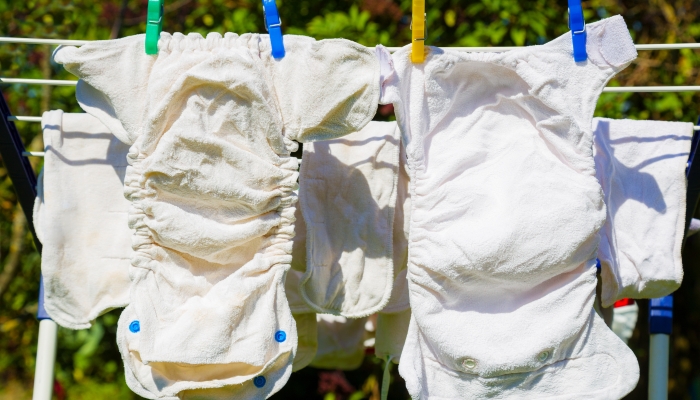
In addition to using various detergents, natural remedies help treat stains. For example, vinegar and baking soda are fantastic at getting poop out of clothes.
Here’s a closer look at how to use vinegar and baking soda to remove stains:
- Create a paste with equal parts baking soda and vinegar.
- Rub the paste directly into the stained area. (You’ll likely want to use gloves.)
- Let the paste sit for at least 30 minutes.
- Wash out the paste.
- Soak your item in hot water and vinegar overnight.
- Run your item through the wash.
Another natural remedy to get the poop out of clothes is sun bleaching, which provides a natural bleaching effect of sunlight.
Remember to pre-treat your clothes before using natural remedies.
FAQs
How often should I wash poop-stained clothes to prevent odor build-up?
You should wash poop-stained clothes immediately to prevent odor build-up. If you’ve tried several methods without luck, it might be time to toss the clothing. Luckily, babies grow fast, so you’ll quickly move on to the next size.
Can poop stains harbor bacteria even after washing?
It’s important to understand that laundry detergent doesn’t kill germs, but bleach and hot water do. According to the Centers for Disease Control and Prevention33. Preventing Waterborne Germs at Home. Centers for Disease Control and Prevention. 2024. https://www.cdc.gov/healthywater/drinking/preventing-waterborne-germs-at-home.html (CDC), water temperatures ranging from 130 to 140 degrees Fahrenheit(°F) can eliminate most harmful bacteria.
Since high water temperatures can cause scalding, it’s vital to use caution when washing clothes in high temperatures.
How do I prevent poop stains on clothes during potty training?
It’s challenging to prevent accidents during potty training; however, training pants can be a compromise between diapers and underwear. In addition, avoid complicated clothing with snaps, buttons, or zippers, which can be challenging if your child is in a hurry to go potty.
You can also try naked potty training, where your child is bottomless while awake.
References
- Anderson, E., & Zagorski, J. (2022, September 26). Trending – Laundry Detergent Enzymes. Center for Research on Ingredient Safety. https://www.canr.msu.edu/news/trending-laundry-detergent-enzymes
- Hede, P. D. (2020, May 7). A beginner’s guide to enzymes in detergents. Novozymes. https://biosolutions.novozymes.com/en/dish/insights/article/beginners-guide-enzymes-detergents
- Preventing Waterborne Germs at Home. Centers for Disease Control and Prevention. (2024, April 3). https://www.cdc.gov/healthywater/drinking/preventing-waterborne-germs-at-home.html
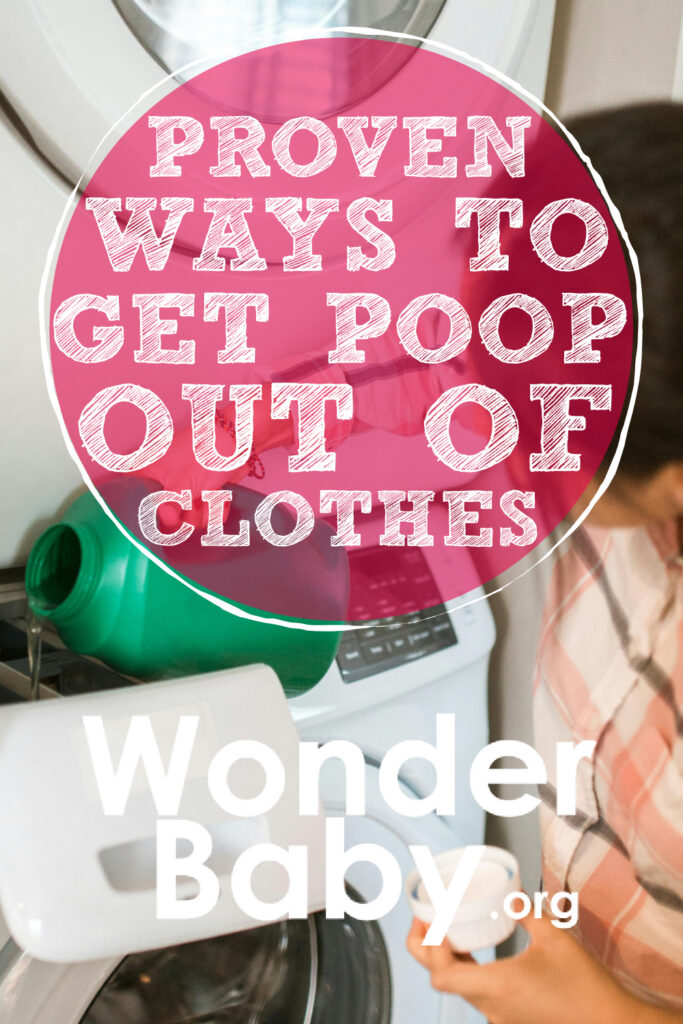
Related Posts

Parenting
Sensory Wall Art: 5 Tips to Create a Room Your Blind or Low-Vision Child Will Love
Even if your child can’t see their surroundings, personalizing and decorating their room with thoughtful, sensory-friendly design can make a big difference in their confidence, independence, and joy.
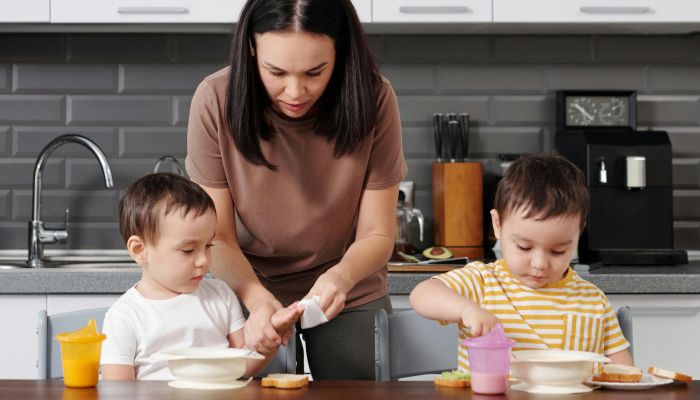
Parenting
4 Tips to Manage Twins Alone as a Single Parent
Taking care of twins alone as a single parent can feel overwhelming. Learn practical ways to help lighten the load.

Parenting
How to Manage Twin Escalation Syndrome
Discover effective strategies for managing twin escalation syndrome, including promoting individuality and fostering positive interactions.





